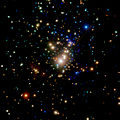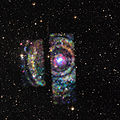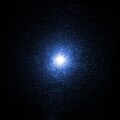Chandra X-ray Observatory
The Chandra X-ray Observatory or CXC for its acronym in English, is an artificial satellite launched by NASA on July 23, 1999. It was named after in honor of the Indian physicist Subrahmanyan Chandrasekhar, one of the founders of astrophysics, who determined the mass limit at which white dwarfs become a neutron star. Also, Chandra means "moon" in sanskrit.
Chandra Observatory is the third of NASA's Great Observatories. The first was the Hubble Space Telescope, the second was the Compton Gamma Ray Observatory, launched in 1991 and now disintegrated, and the last was the Spitzer Space Telescope. Before launch, the Chandra Observatory was known as AXAF for Advanced X-ray A stronomical Facility.
Since the Earth's atmosphere absorbs most of the X-rays, conventional telescopes cannot detect them and a space telescope is necessary to study them.
In 1976 Riccardo Giacconi and Harvey Tananbaum proposed the idea of the Chandra Observatory to NASA, beginning preliminary work at the Marshall Space Flight Center. Meanwhile, in 1978, NASA launched the first X-ray space telescope, the Einstein (HEAO-2).
Despite this, work on the Chandra project continued through the 1980s and 1990s, but in 1992 the ship was redesigned to reduce costs. Four of the twenty mirrors that the observatory was going to have were eliminated, and an elliptical orbit was calculated with which it would reach a third of the distance to the moon. This eliminated the possibility of being repaired by the Space Shuttle, but placed the observatory outside the influence of Earth's radiation belts for most of its orbit.
It was launched by the shuttle Columbia (STS-93) being the heaviest payload the shuttle had ever put into orbit so far.
Chandra can observe the sky in X-rays with an angular resolution of 0.5 arcseconds, a thousand times more than the first orbiting X-ray telescope.
The Chandra X-ray Observatory carries the following instruments:
- Advanced CCD Imaging Spectrometer (ACIS)
- High Resolution Camera (HRC)
- High Energy Transmission Grating Spectrometer (HETGS)
- Low Energy Transmission Grating Spectrometer (LETGS)
Among other objects, it has been used to study RCW 86, the rest of the supernova SN 185.
Examples of discoveries
- The data collected by Chandra have advanced a lot in the field of X-ray astronomy. Here are some examples of discoveries supported by Chandra's observations:
- The first light image, of supernova remnant Cassiopeia A, gave astronomers their first look at the compact object in the center of the remnant, probably a neutron star or a black hole. (Pavlov, et al., 2000)
- In the Crab nebula, another supernova remnant, Chandra showed a ring never seen before around the central pulpsar and jets that had only been partially seen by previous telescopes. (Weisskopf et al., 2000)
- The first X-ray emission was seen from the supermassive black hole, Sagittarius A*, in the center of the Milky Way. (Baganoff et al., 2001)
- Chandra found much more fresh gas than expected in spiral at the center of the Andromeda galaxy.
- The pressure fronts were observed in detail for the first time in Abell 2142, where the groups of galaxies are merging.
- The earliest images in the X-rays of a supernova shock wave were taken from SN 1987A.
- Chandra first showed the shadow of a small galaxy while being cannibalized by a larger one, in a Perseus A image.
- A new kind of black hole was discovered in the M82 galaxy, medium mass objects supposedly the missing link between black star-sized holes and super massive black holes. (Griffiths et al., 2000)
- The X-ray emission lines were first associated with a gamma-ray burst, Beethoven Burst GRB 991216. (Piro et al., 2000)
- High school students, using Chandra data, discovered a neutron star in the rest of the IC 443 supernova.
- Chandra and BeppoSAX's observations suggest that gamma-ray bursts occur in star-forming regions.
- Chandra's data suggested that RX J1856.5-3754 and 3C58, which were previously thought to be pulsars, could be even more dense objects: quartz stars. These results remain discussed.
- The sound waves of violent activity around a super massive black hole were observed in the Perseus Cluster (2003).
- Image CXO of the brown dwarf TWA 5B.
- TWA 5B, a brown dwarf, was seen in orbit around a binary system of stars similar to the Sun.
- Almost all stars in the main sequence are X-ray emitters. (Schmitt and Liefke, 2004)
- Titan's X-ray shadow was seen when he crossed the crab nebula.
- X-ray emissions of materials falling from a protoplanetary disk to a star. (Kastner, et al., 2004)
- Hubble measuring 76.9 km/s/Mpc using the Sunyaev-Zel'dovich effect.
- 2006 Chandra found the strong evidence that dark matter exists observing the wonderful collision of the cluster
- 2006 The X-ray emitting rings and filaments discovered around a super massive black hole inside Messier 87 involve the presence of pressure waves, shock waves and sound waves. The evolution of Messier 87 may have been dramatically affected.
- The observations of the Bullet group set limits to the cross section of the self-interaction of the dark matter.
- "The Hand of God" photograph of PSR B1509-58.
- Jupiter's X-rays from the poles, not the auroral ring.
- A large halo of hot gas was found around the Milky Way.
- An extremely dense and luminous dwarf galaxy M60-UCD1.
- On January 5, 2015, NASA reported that CXO observed an X-ray call 400 times brighter than usual, a break-registers, from Sagittarius A*, a supermassive black hole in the center of the Milky Way galaxy. The unusual fact may have been caused by the rupture of an asteroid that falls into the black hole or by the interlacing of magnetic field lines within the gas that flows into the A* Sagittarius, according to astronomers.
- In September 2016, it was announced that Chandra had detected Pluto X-ray emissions, the first X-ray detection of a Kuiper belt object. Chandra had made the observations in 2014 and 2015, supporting the New Horizons spacecraft for its July 2015 meeting.
Gallery
Contenido relacionado
Heliocentric theory
Obliquity of the ecliptic
Nutation
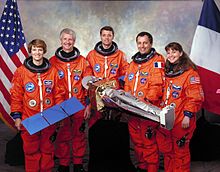


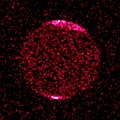






![Brillo de rayos X de Sagitario A*, agujero negro supermasivo en la Vía Láctea.[8]](https://upload.wikimedia.org/wikipedia/commons/thumb/8/85/X-RayFlare-BlackHole-MilkyWay-20140105.jpg/120px-X-RayFlare-BlackHole-MilkyWay-20140105.jpg)


